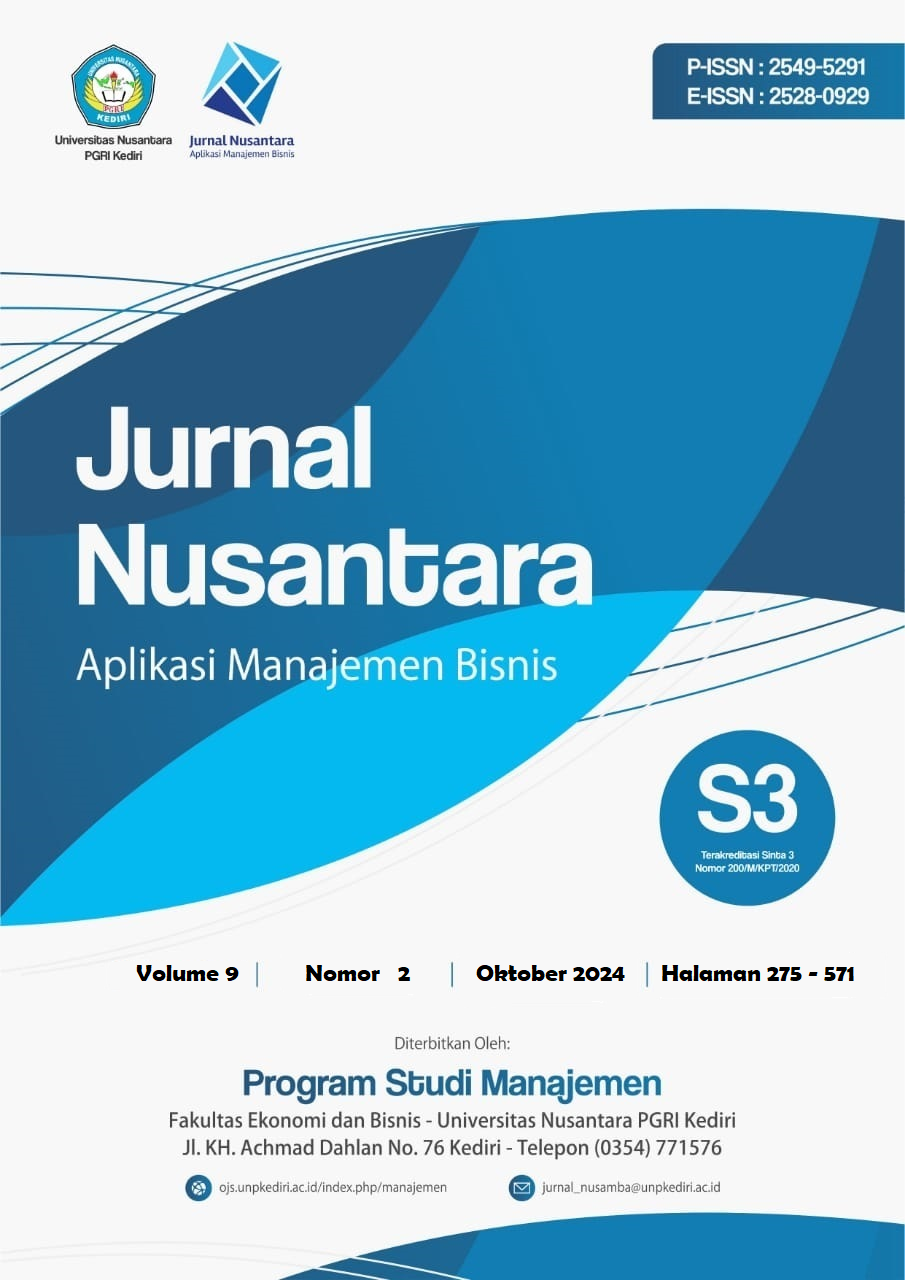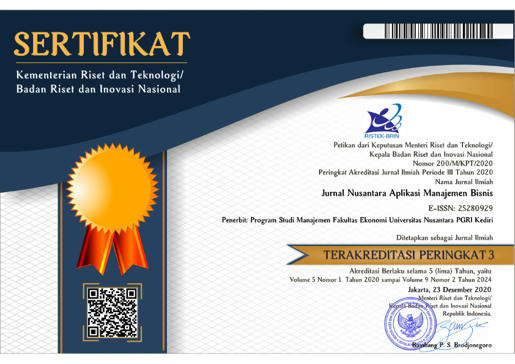Determinan Repurchase Intention Konsumen dalam Berbelanja Busana Muslim secara Online
DOI:
https://doi.org/10.29407/nusamba.v9i2.20207Keywords:
Electronic Word of Mouth, Kepuasan Konsumen, Loyalitas Pelanggan, Repurchase IntentionAbstract
Research aim: To examine the determinants of consumer repurchase intention in shopping for Muslim fashion online.
Methods: Explanatory research using the Structural Equation Modeling method with the SmartPLS3 program.
Research Findings: The results show that consumer satisfaction significantly affects consumer loyalty, which in turn mediates the relationship between consumer satisfaction and repurchase intention. E-WOM does not show a significant effect on repurchase intention either directly or through mediation.
Theoretical Contribution: This study contributes to the e-commerce literature by revealing the relationship dynamics between consumer satisfaction, electronic word of mouth (e-WOM), customer loyalty, and repurchase intention on online platforms.
Practical Implications: The results of this study provide strategic guidance for e-commerce business actors to increase customer loyalty as an important step in encouraging repeat purchases
Research Limitations: This study is limited to the context of Muslim fashion online stores, so the results may not be generalizable to other products or different e-commerce platforms. Further research is needed to explore additional factors that can more comprehensively explain the relationship between consumer satisfaction and repurchase intention.
Downloads
References
A. L. Kusumatrisna et al., Statistik E-Commerce 2021. 2021.
M. D. Ruhamak and B. Rahayu, “Pengaruh Word Of Mouth Terhadap Purchase Intention Melalui Brand Image Pada Lembaga Kursus Bahasa Inggris Dynamic English Course Pare,” Ekonika J. Ekon. Univ. kadiri, vol. 1, no. 2, pp. 188–204, 2017, doi: 10.30737/ekonika.v1i2.14.
I. J. Ismail, “I trust friends before I trust companies: The mediation of WOM and brand love on psychological contract fulfilment and repurchase intention,” Manag. Matters, vol. 19, no. 2, pp. 167–186, 2022, doi: 10.1108/manm-02-2022-0033.
A. Nasir, “Pengaruh Kepercayaan Dan Electronic Word Of Mouth (E-WOM) Terhadap Purchase Intention (Studi Pada Pelajar Kampung Inggris Pare-Kediri),” Ekonika J. Ekon. Univ. kadiri, vol. 4, no. 1, pp. 63–76, 2019, doi: 10.30737/ekonika.v4i1.328.
L. J. Liang, H. C. Choi, and M. Joppe, “Understanding repurchase intention of Airbnb consumers: perceived authenticity, electronic word-of-mouth, and price sensitivity,” J. Travel Tour. Mark., vol. 35, no. 1, pp. 73–89, 2018, doi: 10.1080/10548408.2016.1224750.
M. A. Saleem, S. Zahra, and A. Yaseen, “Impact of service quality and trust on repurchase intentions – the case of Pakistan airline industry,” Asia Pacific J. Mark. Logist., vol. 29, no. 5, pp. 1136–1159, 2017, doi: 10.1108/APJML-10-2016-0192.
J. Matute, Y. Polo-Redondo, and A. Utrillas, “The influence of EWOM characteristics on online repurchase intention: Mediating roles of trust and perceived usefulness,” Online Inf. Rev., vol. 40, no. 7, pp. 1090–1110, 2016, doi: 10.1016/j.redee.2015.03.002.
E. A. Savitri, Z. Zahara, and P. Ponirin, “Pengaruh Promosi Melalui Media Sosial Terhadap Repurchase Intention Melalui Electronic Word of Mouth,” J. Ilmu Manaj. Univ. Tadulako, vol. 2, no. 3, pp. 241–250, 2020, doi: 10.22487/jimut.v2i3.61.
A. Langga, A. Kusumawati, and T. Alhabsji, “Intensive distribution and sales promotion for improving customer-based brand equity (CBBE), re-purchase intention and word-of-mouth (WOM),” J. Econ. Adm. Sci., vol. 37, no. 4, pp. 577–595, 2021, doi: 10.1108/jeas-03-2019-0041.
M. Srivastava and S. Sivaramakrishnan, “The impact of eWOM on consumer brand engagement,” Mark. Intell. Plan., vol. 39, no. 3, pp. 469–484, 2021, doi: 10.1108/MIP-06-2020-0263.
H. C. Kuo and C. Nakhata, “The Impact of Electronic Word-of-Mouth on Customer Satisfaction,” J. Mark. Theory Pract., vol. 27, no. 3, pp. 331–348, 2019, doi: 10.1080/10696679.2019.1615840.
A. Serra-Cantallops, J. Ramón Cardona, and F. Salvi, “Antecedents of positive eWOM in hotels. Exploring the relative role of satisfaction, quality and positive emotional experiences,” Int. J. Contemp. Hosp. Manag., vol. 32, no. 11, pp. 3457–3477, 2020, doi: 10.1108/IJCHM-02-2020-0113.
R. Anaya-Sánchez, R. Aguilar-Illescas, S. Molinillo, and F. J. Martínez-López, “Trust and loyalty in online brand communities,” Spanish J. Mark. - ESIC, vol. 24, no. 2, pp. 177–191, 2020, doi: 10.1108/SJME-01-2020-0004.
Saodin, “Pengaruh E-Servqual Terhadap E-Satisfaction, E-WOM Dan Online Repurchase Intention,” J. Ilm. Ekon. Manaj., vol. 12, no. 1, pp. 15–30, 2021, doi: 10.52657/jiem.v12i1.1450.
Y.-O. Lee and M. Kim, “The effect of logistics service quality on customer satisfaction and repurchase intention: focusing on company size as a moderator,” J. Int. Logist. Trade, vol. 6, no. 1, pp. 55–73, 2008, doi: 10.24006/jilt.2008.6.1.55.
Y. Kartika and M. S. Shihab, “Membangun Positive E-Wom Melalui E-Service Quality, Kepercayaan Dan Kepuasan,” J. Entrep. Manag. Ind., vol. 2, no. 4, pp. 195–204, 2019, doi: 10.36782/jemi.v2i4.1942.
B. Anidayati and I. Susila, “Analisis Pengaruh Electronic Word Of Mouth, Kepercayaan, Dan Kepuasan Pelanggan Terhadap Niat Beli Ulang Konsumen Di Media Sosial dengan Adopsi Informasi Sebagai Variabel Mediasi (Studi Pada Produk Skincare Di Marketplace Shopee),” SEIKO J. Manag. Bus., vol. 6, no. 1, pp. 438–454, 2023, doi: 10.37531/sejaman.v6i1.3745.
N. K. A. Y. Sari and N. M. Rastini, “Pengaruh E-WOM, Kepercayaan, Dan Kepuasan Terhadap Niat Beli Kembali: Studi Pada Pelanggan Situs Shopee,” E-Jurnal Manaj. Univ. Udayana, vol. 11, no. 4, pp. 635–657, 2022, doi: 10.24843/ejmunud.2022.v11.i04.p01.
N. P. S. Yundari and I. M. Wardana, “Pengaruh Brand Image, Consumer Satisfaction, Electronic Word Of Mouth Terhadap Niat Menggunakan Kembali,” E-jurnal Manaj., vol. 8, no. 7, pp. 4647–4675, 2019.
Y. H. Fang, C. M. Chiu, and E. T. G. Wang, “Understanding customers’ satisfaction and repurchase intentions: An integration of IS success model, trust, and justice,” Internet Res., vol. 21, no. 4, pp. 479–503, 2011, doi: 10.1108/10662241111158335.
D. Ribbink, S. Streukens, A. C. R. Van Riel, and V. Liljander, “Comfort your online customer: Quality, trust and loyalty on the internet,” Manag. Serv. Qual. An Int. J., vol. 14, no. 6, pp. 446–456, 2004, doi: 10.1108/09604520410569784.
F. A. Manullang and Heryenzus, “Pengaruh Service Quality, Trust dan Satisfaction Terhadap Repurchase Intention Pada Pengguna Online PT Great Seasons Travel,” eCo-Buss, vol. 5, no. 1, pp. 362–374, 2022.
R. A. Wiatna and Sanaji, “Pengaruh E-Service Quality terhadap Repurchase Intention melalui E- Satsifaction pada Pengguna Aplikasi E-Grocery,” Nomicpedia J. Econ. Bus. Innov., vol. 2, no. 2, pp. 142–158, 2022.
A. Ampountolas, “Peer-to-peer marketplaces: a study on consumer purchase behavior,” J. Hosp. Tour. Insights, vol. 2, no. 1, pp. 37–54, 2018, doi: 10.1108/JHTI-05-2018-0028.
S. Laparojkit and M. Suttipun, “The causal factors influencing repurchase intentions of local tourists in Thailand during COVID-19 crisis,” J. Tour. Futur., vol. ahead-of-p, no. ahead-of-print, pp. 1–16, 2022, doi: 10.1108/JTF-05-2021-0122.
X. D. Chauke and M. Dhurup, “A generation X Cohort analysis of E-shoppers: Satisfaction, loyalty and repurchase intentions in a developing country,” J. Soc. Sci., vol. 52, no. 1–3, pp. 145–154, 2017, doi: 10.1080/09718923.2017.1359908.
J. M. Garcia, O. B. D. L. Freire, E. B. A. Santos, and J. Andrade, “Factors affecting satisfaction and loyalty to online group buying,” Rev. Gest., vol. 27, no. 3, pp. 211–228, 2020, doi: 10.1108/REGE-02-2018-0037.
P. K. Hellier, G. M. Geursen, R. A. Carr, and J. A. Rickard, “Customer repurchase intention: A general structural equation model,” Eur. J. Mark., vol. 37, no. 11/12, pp. 1762–1800, 2003, doi: 10.1108/03090560310495456.
J. Kim, B. Jin, and J. L. Swinney, “The role of etail quality, e-satisfaction and e-trust in online loyalty development process,” J. Retail. Consum. Serv., vol. 16, no. 4, pp. 239–247, 2009, doi: 10.1016/j.jretconser.2008.11.019.
T. T. M. D. Do and L. N. Pereira, “Understanding Vietnamese consumers’ perception and word-of-mouth intentions towards Airbnb,” J. Hosp. Tour. Technol., vol. 14, no. 2, pp. 83–101, 2023, doi: 10.1108/JHTT-12-2020-0321.
Z. Kankhuni and C. Ngwira, “Overland tourists’ natural soundscape perceptions: influences on experience, satisfaction, and electronic word-of-mouth,” Tour. Recreat. Res., vol. 47, no. 5–6, pp. 591–607, 2022, doi: 10.1080/02508281.2021.1878653.
H. Hsin Chang and H. W. Wang, “The moderating effect of customer perceived value on online shopping behaviour,” Online Inf. Rev., vol. 35, no. 3, pp. 333–359, 2011, doi: 10.1108/14684521111151414.
V. Kaura, “Service Convenience, Customer Satisfaction, and Customer Loyalty: Study of Indian Commercial Banks,” J. Glob. Mark., vol. 26, no. 1, pp. 18–27, 2013, doi: 10.1080/08911762.2013.779405.
M. Majeed, C. Asare, A. Fatawu, and A. Abubakari, “An analysis of the effects of customer satisfaction and engagement on social media on repurchase intention in the hospitality industry,” Cogent Bus. Manag., vol. 9, no. 1, pp. 1–19, 2022, doi: 10.1080/23311975.2022.2028331.
Downloads
Published
Issue
Section
License
Authors who publish with this journal agree to the following terms:
- Copyright on any article is retained by the author(s).
- The author grants the journal, the right of first publication with the work simultaneously licensed under a Creative Commons Attribution License that allows others to share the work with an acknowledgment of the work’s authorship and initial publication in this journal.
- Authors are able to enter into separate, additional contractual arrangements for the non-exclusive distribution of the journal’s published version of the work (e.g., post it to an institutional repository or publish it in a book), with an acknowledgment of its initial publication in this journal.
- Authors are permitted and encouraged to post their work online (e.g., in institutional repositories or on their website) prior to and during the submission process, as it can lead to productive exchanges, as well as earlier and greater citation of published work.
- The article and any associated published material is distributed under the Creative Commons Attribution-ShareAlike 4.0 International License












